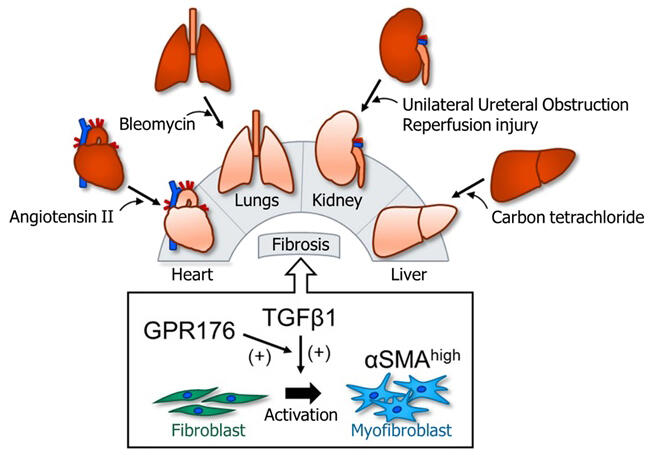A research group led by Professor Yasuo Okamoto of the Department of Pharmacology at Kawasaki Medical School, has announced their research results showing that the expression of "GPR176," an orphan G protein-coupled receptor (GPCR), is commonly increased in fibrosis models of the lung, kidney, liver, and heart. It is assumed that GPR176 is coupled with Gz protein and promotes fibrosis by enhancing the TGFβ1 pathway in fibroblasts. The findings are expected to contribute to the development of diagnostic and therapeutic methods for fibrosis. The results were published in the international journal Biochimica et Biophysica Acta-Molecular Cell Research on July 22.

Provided by Kawasaki Medical School
Fibrosis is a phenomenon in which organs become stiff due to increased stromal cells and excessively accumulated extracellular matrices, such as collagen. As fibrotic organs are dysfunctional and are related to disease progression and treatment tolerance, the development of therapeutic agents for fibrosis has been awaited.
To date, the research group has conducted research aiming at elucidating the pathogenic mechanism of pulmonary fibrosis. In this study, they identified GPR176 as a GPCR whose expression levels are commonly increased in mouse models of pulmonary, renal, hepatic, and cardiac fibrosis. The expression of GPR176 in fibroblasts isolated from fibrotic lungs was higher than that in other lung constituent cells. Knockdown of GPR176 or Gz in fibroblast cell lines reduced TGFβ1-induced Smad2 phosphorylation and suppressed the increased expression of the myofibroblast differentiation marker αSMA and the extracellular matrices collagen and fibronectin.
These findings suggest that GPR176 positively regulates the differentiation (activation) of fibroblasts to myofibroblasts. Reducing the activity of the GPR176 receptor was shown to be a potential treatment strategy for fibrosis.
Okamoto said, "We reported the fibrosis-promoting effect of GPR176 in this study. To develop new GPR176-targeted diagnostic, prophylactic, and therapeutic methods for organ fibrosis, further studies are needed, including clarification of the GPR176-mediated fibroblast activation mechanism and ligand search and functional analysis of GPR176."
Journal Information
Publication: Biochimica et Biophysica Acta - Molecular Cell Research
Title: GPR176 promotes fibroblast-to-myofibroblast transition in organ fibrosis progression
DOI: 10.1016/j.bbamcr.2024.119798
This article has been translated by JST with permission from The Science News Ltd. (https://sci-news.co.jp/). Unauthorized reproduction of the article and photographs is prohibited.




